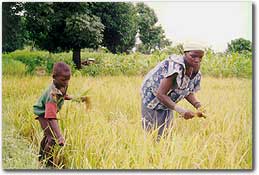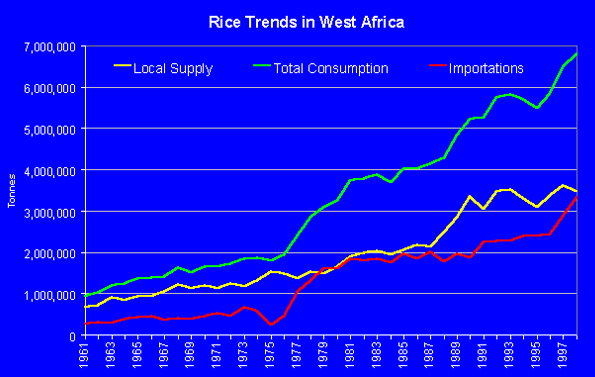|

Bintu is typical of West Africa’s 20 million rice
farmers—most are women. Bintu farms about 1 hectare in southern
Côte d’Ivoire, or the Ivory Coast. She’s bound to an
environmentally degrading, slash-and-burn farming system.
Bintu clears brush from new land, then plants rice seeds of
the Asian rice species that entered Africa about 450 years ago.
But Asian rices—developed for high-input irrigated farming—can’t
compete with the weeds on Bintu's rainfed farmland, which soon
take over. So, after a crop or two, Bintu must clear more land.
She would rather plant the traditional African rice species
that her ancestors grew. It has wide, droopy leaves that smother
weeds, and has thrived in harsh environments for 3500 years. The
African rice also resists drought, acid soils, and local pests
that plague the Asian rices.
Bintu also likes how the African rice tastes. It’s served at
weddings and festivals.
But Bintu can’t plant her traditional African rice, because
it doesn’t produce enough to feed her family—much less enough to
sell surplus grain.
For years, scientists have dreamed of combining the
ruggedness of the African species with the productivity of the
Asian species. But the two are so different, attempts to cross
them have failed. Until now.
Advances in agricultural research in recent years have helped
scientists cross the two species—a breakthrough that is changing
Bintu’s life. Using a technique called embryo-rescue, scientists
are able to assure that crosses between the two varieties
survive and grow to maturity. The new rice for Africa,
like its African parent, smothers grain-robbing weeds,
and resists drought, pests and problem soils. It also inherited
higher productivity from the Asian species, and can double
production with just a few inputs.
Rice in West
Africa
Nowhere is the struggle for food more desperate than in West
Africa—home to 240 million, one of every three persons on the
continent. More than half the population survives, somehow, on
less than one US dollar per day.
"Keep in mind that ‘food’ means ‘rice’ for many people in
West Africa today," says Dr Kanayo F. Nwanze, director general
of the
West Africa Rice
Development Association (WARDA), based
in Côte d’Ivoire. It was WARDA that developed the rices, dubbed
NERICAs (NEw RIce for AfriCA).
"Ironically, rice was considered a luxury food in West Africa
only two decades ago," Nwanze adds. "Today, it’s the staple."
Rice now contributes more calories and protein than any other
cereal in humid West Africa, and about the same as all roots and
tubers combined. Demand for rice is growing faster here than
anywhere in the world.
In three decades, rice imports have increased eight-fold, to
over 3 million tonnes a year, at a cost of almost US$ 1 billion.

About 40% of West Africa’s 4.1 million hectares of rice is
upland, or dryland, grown like wheat or maize. Fertilizer and
pesticide use is minimal, and yields are only about 1 tonne per
hectare.
Breeding strategy
"The African and Asian species evolved separately over
millennia," explains Dr Monty Jones, WARDA rice breeder. The
African species lodges, or falls over, when grain heads fill. It
also shatters easily, wasting more precious grain. The
higher-yielding Asian species has largely replaced its African
cousin.
West African farmers in rainfed (dryland) areas can’t grow
the semidwarf rices that have revolutionized irrigated
production in Asia, because they don’t compete well with weeds,
or tolerate drought and local pests. And African farmers are too
poor to invest much in herbicides, other pesticides, or
fertilizers.
In 1991, Monty Jones initiated a biotechnology-based program
to combine the best traits of the Asian and African rices. Key
to the effort were gene banks that hold seeds of 1500 African
rices—which had faced extinction as farmers abandoned them for
higher-yielding Asian varieties.
Traits of the New Rice for Africa
Scientists were testing the new rice for Africa—progeny
of African–Asian crosses—in rainfed conditions by the mid-1990s.
"Genetic differences in the two species made breeding
difficult—but also gave the new rices high levels of
heterosis or hybrid vigor," Jones says. Heterosis is
the phenomenon in which the progeny of two genetically different
parents grow faster, yield more, or resist stresses better than
either parent.
Weeding accounts for 30 to 40% of all labor—mostly by women
and children—invested in a West African rice crop.
The NERICAs inherited wide, droopy leaves from their African
parent, which smother weeds in early growth. That reduces labor,
and allows farmers to work the same land longer, rather than
having constantly to clear new land.

The structure of the panicles, or grain heads, has also been
changed. Panicles of the African species produce only 75-100
grains. The new rices inherited, from their Asian parent, longer
panicles with ‘forked’ branches, and hold up to 400 grains.
Like their Asian parent, the new rices hold grains tightly,
not allowing them to shatter. They produce more tillers than
either parent, with strong stems to support the heavy grain
heads.
The new rices outyield others with no inputs—but respond
bountifully to even modest fertilization.
"In trials, we’re getting yields as high as 2.5 tonnes per
hectare at low inputs—and 5 tonnes or more with just minimum
increase in fertilizer use," Jones says. "We’re talking about
25% to 250% production increases."
The new rices mature 30 to 50 days earlier than current
varieties, allowing farmers to grow extra crops of vegetables or
legumes. They’re taller than most rices, which makes harvesting
easier—especially for women with babies strapped to their backs.
They resist pests and tolerate drought better than the Asian
rices—vitally important for rainfed-rice farmers. The new rices
grow better on infertile, acid soils—which comprise 70% of West
Africa’s upland rice area.
They also have about 2% more body-building protein than their
African or Asian parents.
Dr Susan McCouch of Cornell University and the Rockefeller
Foundation Rice Biotechnology Program is helping develop a
molecular map of the new rices, plotting genes that control
traits like droopy leaves.
"Using biotechnology to exploit genes from the African
species could significantly increase global biodiversity in
rice," McCouch says.
Spread and hope for the future
More than 1300 farmers participated in a 1998 program to
start the new rices in Guinea, followed by a 1999 national seed
increase and farmer awareness program. Average farm yields are
rising from about 1 tonne to more than 1.5 tonnes per hectare
with low inputs—and at least double that with good management
and intermediate inputs.
WARDA projects that farmers will grow the new rices on almost
5000 hectares in Guinea in 2000, and 330,000 ha by 2002.
Several new NERICA rices, yielding at least 25% more than
conventional varieties, will be released in West Africa in 2000.
Research shows that 10% adoption in just three countries—Guinea,
Côte d’Ivoire and Sierra Leone—will return an extra US$ 8
million to farmers per year. Adoption by 25% of farmers will
return $20 million.
The new rice for Africa may also help farmers who grow upland
rice on 17 million ha in Asia, and 4 million ha in Latin
America.
|